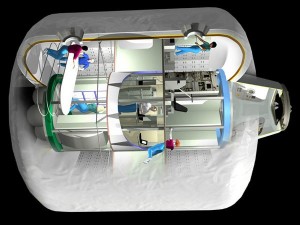Spacecraft are cramped. But a new hab under development by a NASA subcontractor may change that. The company is building inflatable modules useful for man or machine that would allow astronauts room to stretch their legs. Make it big enough and a person could fly through it like a dream:
Space.com — NASA and Bigelow Aerospace have reached an agreement that could pave the way for attaching a Bigelow-built inflatable space habitat to the International Space Station, a NASA spokesman said. The $17.8 million contract was signed in late December, NASA spokesman Trent Perrotto told SpaceNews Monday (Jan. 7). Perrotto declined to provide other terms of the agreement, except to say that it centers around the Bigelow Expanded Aerospace Module (BEAM).


If it got punctured PBTHTHRRRRRRRPTHTHRRRRRRRPTHTHRRRRRRRP like a balloon whizzing around the room??
Just asking :-)
I’ve been following these inflatable things for a while, and I’m very impressed and hopeful. I really think this is the future. They’re lightweight, they’re huge, and with the right materials they can be just as resistant against micrometeoroids and radiation.
You link a few of these things together, and you sir have yourself a space-bound community. And such low mass and low cost! Och, the future is so bright I’m going to need sunglasses.
Slap a skin of solar cells on the outside?
Why not develop inflatable housing for earthbound types? Instant cabin in the woods.
John M. Ford has made it permanently impossible for me to read a story like this, no matter how serious, without giggling.
“Maybe it’s just the idea of an inflatable rubber starship that bothers me.”
— Kirk, in How Much For Just The Planet?
Slap together a few dozen of those, add some inflatable units for bulk gas storage, release a fleet of ’em cruising the interplanetary transport network — hello fusion-fuel extraction economy, complete with shipping lanes and cargo-ship/supertanker equivalents looking like giant clusters of balloons!
…has this been used in a science fiction novel? If not, I might have to start working out the logistics and write it myself. (Hm…would solar wind pressure alone be enough to make transportation in gas form less efficient than compressed to liquid? How slow, exactly, is the interplanetary transport network; I haven’t spent much time on orbital dynamics, so for all I know it could be anywhere from “long tall-ship-era trading voyage” to “generational commitment”. And how would the whole process affect the Saturn-to-Earth “trucker” subculture, especially if there’s a pressure to cut costs by minimizing crew size, leading to long-term lack of human contact?)
@davedell: Simple, because surface inflatables’ pressure has to be much higher and is therefore much more susceptible to leaks. Complicated: fire, wind, thieves; problems you don’t have in Space.
There’s a wonderful tour of the ISS here: http://www.slate.com/blogs/bad_astronomy/2012/12/15/space_station_tour_commander_sunita_williams_shows_you_her_orbiting_home.html
And much as I’ve wanted to go to space for many decades, I look at that huge heap of clutter and wonder how the astronauts don’t go crazy.
A few years ago, the Bigelow modules seemed looneytunes, but I gave them some respect as they did have some amount of funding and other people took them seriously.
I hope they work out, our astronauts need some room.
Good idea – looking forward to seeing it fly – & orbit.
PS. Did I forget to add the word “Cheers!” to #7? I did? Well, then here it is :
Cheers for that.
@nakarti Thanks for the tip about pressure. So obvious once it’s pointed out. Makes me want to slap my forehead and say, “doh”.
I recall the Space Station concepts from my Sci Fi obsessed youth. Giant torus shapes with big cylindrical spokes and a hub. Roomy with spin for artificial gravity. I must have read Clarke’s ‘Islands in the Sky’ six times. Heavy sigh…
I read that as “explosive space modulator.”
The vacuum of space helps you inflate things. And you can always fill the space with some sort of material – it need not permanently a gas. You could inflate it and fill it with epoxy.
I’d be very interested in the safety protocols they’d have in place for depressurisation of inflatable spacecraft – double inflatable hulls, I assume, and then the design of compartments within the craft.
Just looked it up, the ISS operates at sea level pressurization. Would inflatable spacecraft also use that as default, or are there optimisation possibilities, especially in non-living space compartments?